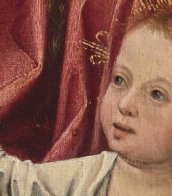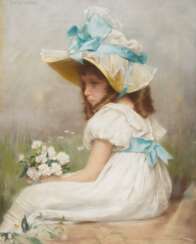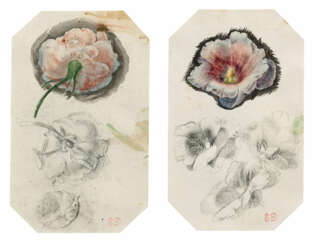акварель, рисунки и пастель





Alfred August Felix Bachmann, a distinguished German Orientalist painter, carved a niche for himself in the realm of art with his exceptional talent. His journey in art began post-high school, under the tutelage of Max Schmidt at the Königsberg Academy of Art, eventually leading him to explore and derive inspiration from various European locales. Bachmann's dedication to his craft saw him making Munich his home from 1891 onwards, immersing himself in the city's vibrant art scene.
Bachmann's oeuvre primarily showcases his profound connection with coastal landscapes, though his versatility also shines through in his depictions of prairies and hilly terrains. His participation in the prestigious exhibitions at the Glaspalast in Munich since 1887 underscores his prominence in the art world. Notably, his artistic excellence was recognized with a gold medal at the Glaspalast exhibition in Berlin in 1913, an Austrian Grand Gold Medal Service Award in 1917, and the German Service Cross in 1952, attesting to his significant contributions to art.
His artistic journey included an intriguing role appointed by Otto Erich Hartleben to the "Halkonian Academy for Unexplored Sciences," where Bachmann created a poignant last portrait of Hartleben, titled "Last Greetings." This work, among others, demonstrates Bachmann's deep intellectual and emotional engagement with his subjects.
Bachmann's legacy is celebrated in many esteemed collections, evidencing the lasting impact of his works on the art community and collectors alike. His contributions to Orientalist painting and his unique ability to capture the essence of his subjects have solidified his place in art history.
For art collectors and enthusiasts keen on exploring the works of Alfred August Felix Bachmann, signing up for updates can enrich your collection with pieces that not only exemplify exquisite craftsmanship but also carry historical significance. Stay informed about new sales and auction events dedicated to Bachmann's art by subscribing for updates today.


Franz von Stuck was a German painter, sculptor, printmaker, and architect. Stuck was best known for his paintings of ancient mythology, receiving substantial critical acclaim with The Sin in 1892.


Ferdinand Victor Eugène Delacroix was a French Romantic artist, celebrated for revolutionizing the art world with his expressive brushstrokes and masterful use of color. Delacroix's art is characterized by its emotional intensity, vibrant colors, and dramatic themes, often drawing inspiration from historical, literary, and exotic sources. His innovative techniques and passion for expressive content made him a pivotal figure in the transition from the Neoclassical to the Romantic movement, influencing both the Impressionist and Symbolist movements that followed.
Delacroix's fascination with the exotic and the sublime led him to North Africa in 1832, where he captured the spirit and colors of Moroccan life, influencing his later works with themes of orientalism. This trip inspired masterpieces such as "Women of Algiers in their Apartment" (1847-1849), showcasing his ability to blend vivid color with intricate detail to evoke a sense of place and culture. His masterpiece, "Liberty Leading the People" (1830), is emblematic of his political engagement and artistic audacity, capturing the spirit of the 1830 revolution with a realism and fervor that resonated with the public and critics alike.
Delacroix's legacy extends beyond his paintings. As a muralist and lithographer, he left a significant mark on public and private art collections, with works displayed in prestigious institutions like the Louvre. His impact on the art world is seen in his influence on subsequent generations of artists, from the Impressionists' exploration of color and light to the Symbolists' fascination with dreamlike and exotic themes.
For collectors and experts in art and antiques, Delacroix represents not only a high point in Romantic art but also a bridge to modern artistic expressions. His works, housed in museums around the world, continue to inspire and captivate audiences with their intensity and beauty.
If you're passionate about Delacroix's contribution to art and culture, consider subscribing for updates on new product sales and auction events related to this iconic artist. Stay informed on opportunities to add a piece of art history to your collection.


Salomon Corrodi was an Italian-Swiss watercolor painter.
At the age of twenty-two, Corrodi moved from Zurich to Italy, his parents' homeland, and took up the study of watercolor landscape painting in Rome with Jacob Suter (1805-1874). He traveled and painted landscapes extensively, and by the mid-19th century had become a recognized master of watercolor landscape painting as well as a teacher.
Salomon Corrodi lived a long and productive life, laboring until his death and producing many exquisite landscapes of coastal and mountain vistas as well as vedutas. Two of his sons, Herman and Arnold, also became artists.


Salomon Corrodi was an Italian-Swiss watercolor painter.
At the age of twenty-two, Corrodi moved from Zurich to Italy, his parents' homeland, and took up the study of watercolor landscape painting in Rome with Jacob Suter (1805-1874). He traveled and painted landscapes extensively, and by the mid-19th century had become a recognized master of watercolor landscape painting as well as a teacher.
Salomon Corrodi lived a long and productive life, laboring until his death and producing many exquisite landscapes of coastal and mountain vistas as well as vedutas. Two of his sons, Herman and Arnold, also became artists.


Karl Paul Themistokles von Eckenbrecher was a German landscape and marine painter, in the late Romantic style.


Jean-Édouard Vuillard was a French artist, celebrated for his role in the avant-garde group Les Nabis. Known for his decorative art and printmaking, Vuillard's work was heavily influenced by Japanese prints, which is evident in his unique style of flattened color planes and simplified forms. His paintings, often of interior scenes, are distinguished by their intimate and domestic subjects, displaying a keen sensitivity to the subtle dynamics of everyday life.
In the late 1880s, Vuillard joined Les Nabis, a group of artists who sought to break away from traditional artistic concepts. This association played a pivotal role in shaping his artistic philosophy. Vuillard’s early works, like "The Seamstresses" (1890) and "Child in an Orange Shawl" (1894–95), demonstrate his evolving style, marked by the use of vibrant colors and a distinct lack of perspective, aimed at exploring spatial relationships.
Vuillard's artistic journey included ventures into theater decoration and interior design. He designed stage sets and theater programs, notably for Lugné-Poe's Theatre de l’Oeuvre, and also worked on large-scale panel paintings for French patrons. His close collaboration with the Natanson brothers, founders of the cultural review La Revue Blanche, was significant in his career. This association brought him various commissions, including decorative works for private homes and public buildings.
Vuillard's art evolved over time, transitioning from his Nabis-style works to more naturalistic portraits in the 1920s and 1930s. Despite this shift, his focus remained on portraying the intricacies of domestic life, often featuring the people closest to him. Notable among his subjects were Misia Natanson, a prominent figure in the Parisian cultural scene, and Lucy Hessel, with whom Vuillard had a long-term relationship.
For art collectors and experts, Vuillard's works are a window into the intimate spaces of Parisian life at the turn of the century. His ability to transform everyday scenes into art makes his work particularly appealing. Pieces like "The Green Interior" (1891) and "Breakfast at Villerville" (1910) are exemplary of his style and are celebrated for their quiet yet profound depiction of ordinary life.
Vuillard's legacy lives on in galleries and museums worldwide. His work remains a testament to the power of domestic scenes in art, capturing the essence of the period with a unique blend of realism and abstraction.
For those interested in the subtle beauty of Vuillard's work, subscribing to our updates will ensure you stay informed about new sales and auction events featuring his art. Our updates are tailored for connoisseurs like you, providing insights into the world of art and antiques, with a focus on Vuillard's enduring legacy.


































































